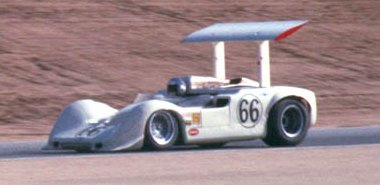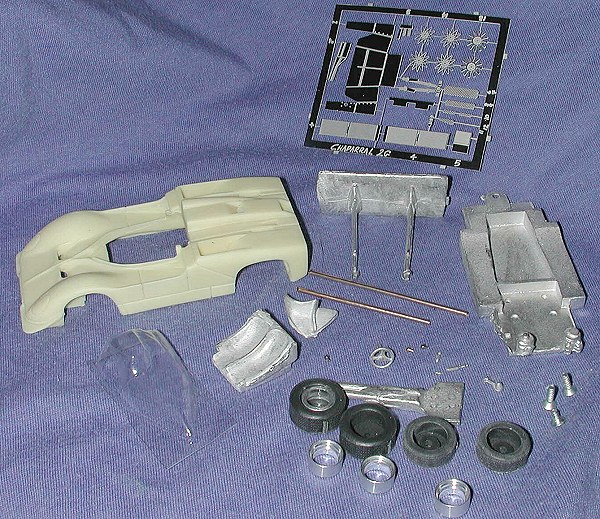
|
KIT: |
Marsh Models 1/43 Chaparral 2G |
|
KIT # |
MM34B |
|
PRICE: |
$56.00 |
|
DECALS: |
Two cars |
|
REVIEWER: |
|
|
NOTES: |
Multimedia kit |

|
HISTORY |
In 1966, Hall shocked the racing community by mounting a wing, upside down, on two vertical struts on the back of his Chaparral 2E cars. Working like an airplane wing, only upside down, it generated downforce (instead of lift) to keep the rear of the car stuck to the ground. The radiators were relocated from the front of the car to the sides so that a wing could be mounted inside the front bodywork to keep the front down.
The wings were also movable. The Chaparrals used an automatic transmission, so there was no clutch pedal, which allowed Hall to add a third pedal. While accelerating, the driver would hold the pedal down with his left foot. This kept the wings horizontal for less drag. Releasing the pedal put the wings in an angled position, for greater downforce in the corners (the increased drag also helping slow the car).
Jim Hall teamed with Phil Hill, who had become the first American to win the Formula One World Driving Championship in 1961, to drive Chaparrals in 1966. Chaparrals set fastest qualifying time twice that season (Hall once and Hill once) and Hill gained the team's first Can-Am win on October 16, 1966, at Laguna Seca, California.
For 1967, Chaparral entered a revised version of the 2E called the 2G. The 2G was wider and aerodynamically cleaner than the 2E, but the aluminum chassis wasn't built for the amount of torque being put out by the team's 427 cubic inch Chevrolet engines. (It was better suited to the 327 cubic inch engine used in their 2F endurance racing coupes and the 2E, but they were committed to the big block.) As a result, the cars were plagued with breakdowns and DNFs. A horrific crash in a 2G at Las Vegas in 1968 ended Jim Hall's driving career, though he continued on as chief designer and team owner.
|
THE KIT |

Those who build 1/43 multi-media kits will instantly recognize this as pretty well the standard format for these kinds of kits. It combines resin, cast metal, etched metal and vacuformed parts. Though the parts count is not high, I can tell you from experience that these kits are not a breeze to build. The metal castings are a bit rough and will require some careful clean-up prior to use. No extra vacuformed windscreen is provided, though it would be quite nice to have a back-up. The resin is fairly well done, but a tad rough on the edges and does need some clean-up. I did find a couple of air bubble which will have to be dealt with during construction. I personally find it interesting that they chose to cast the rear wing in metal. The amount of clean-up needed for this will be great and I personally wish they'd chosen resin for it instead. We'll see how the build goes.
The instructions are basically a pair of exploded views and each of the
parts is given a painting guide which is nice to have. A few detail
drawings shows the installation of some of the more tricky duct work. No
photos are given though a top and
 side
drawing are provided for decal placement. The internet will be useful in
this regard as there are many Chaparral sites. This is an early car without
the huge rear fender bulges used to clear the enormous tires eventually
used by this car.
side
drawing are provided for decal placement. The internet will be useful in
this regard as there are many Chaparral sites. This is an early car without
the huge rear fender bulges used to clear the enormous tires eventually
used by this car.
Markings for the kit are generic Chaparral for both the 2E and 2G versions. One simply has to pick the combination of markings needed for the car that is being built. Decals are very well printed and judging from a previous build, should work quite well. Race cars of the day were not festooned with sponsor logos as they are today and in many ways that makes them seem that much sleeker and purposeful. While not as wildly colorful as today's cars, the competition and racing were in many way much purer and not driven by the flood of money and hype that goes along with professional racing.
|
CONCLUSIONS |
I'm very much looking forward to building this. My tastes have had a bit of a renewal in the realm of Can Am and sports cars of the period and this one will fit in beautifully.
If you would like your product reviewed fairly and quickly by a site that has over 200,000 visitors a month, please contact me or see other details in the Note to Contributors.